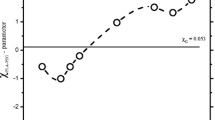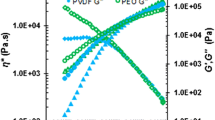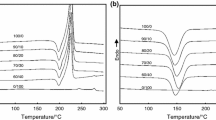Abstract
To effectively improve the performance and expand the applications of polymers, molecular dynamics (MD) simulations with the COMPASS force field have been applied to predict the miscibility, glass transition temperature (Tg), and mechanical properties of poly(vinyl chloride)/dioctyl phthalate (PVC/DOP) blends. The solubility parameter values obtained are in good agreement with the reference data and the little difference (∣Δδ∣ < 2.0 MPa0.5) between two components indicates that PVC/DOP is a miscible system. Tg is predicted by the slope of the free volume and density versus temperature simulation data based on density and free volume theory which is agree well with the experimental data. In addition, the analyses of mechanical properties results indicate that the values of Young’s modulus (E), bulk modulus (K), and shear modulus (G) decrease with the addition of DOP, demonstrating that the rigidity of material is weakened and the ductility is improved. The mechanical properties can also be effectively improved by increasing the temperature, which may provide a more flexible mixture, with lower E, K, G but an increased ductility.
Similar content being viewed by others
References
Zhou, L. L.; Wang, B. B.; Xiao, L. F.; Liang, J. F. Testing and analysis of properties of PVC plasticized with environment-friendly plasticizers. Chemical Research and Application (in Chinese) 2018, 30, 597–601. https://doi.org/10.1007/s10118-019-2249-5
Li, X. G.; Zhao, J.; Fei, Y. N.; Sun, G. F.; Li, J.; Sui, Z. Y.; Yu, H. B. Synthesis of environmental plasticizer di(2-ethylhexy)-1, 2-cyclohexane dicarboxylate. Journal of Petrochemical Universities (in Chinese) 2013, 26, 33–36.
Zhang, D. H.; He, M.; Hu, Z.; Guo, J. B. Effect of content of plasticizer DOP on the properties of soft PVC. Plastic Additives (in Chinese) 2015, 43–44.
Liu, Y. H.; Xing, G. Q.; Feng, B. L.; Chen, L. Z. Application of environment-friendly plasticizers in PVC gloves. Plastic Additives (in Chinese) 2017, 21–22.
Starnes, W. H. Structural defects in poly(vinyl chloride). J. Polym. Sci.; Part A: Polym. Chem. 2005, 43, 2451–2467.
Hu, W. T.; Li, J. G.; Ding, X. J.; Liu, F. J.; Wei, Y. F. Modification of plasticized PVC with three kinds of modifiers. China Plastics (in Chinese) 2014, 28, 60–64.
Xu, H. Z.; Tang, W.; Tan, L. L. Advances in research and development of environment-friendly Ca/Zn heat stabilizers complex for PVC. Plastic Additives (in Chinese) 2008, 8, 11–15.
Li, J.; Jin, S. H.; Lan, G. C.; Chen, S. S.; Li, L. J. Molecular dynamics simulations on miscibility, glass transition temperature and mechanical properties of PMMA/DBP binary system. J. Mol. Graph. Model. 2018, 84, 182–188.
Luo, Y. L.; Wang, R. G.; Wang, W.; Wang, W.; Zhang, L. Q.; Wu, S. Z. Molecular dynamics simulation insight into two-component solubility parameters of graphene and thermodynamic compatibility of graphene and styrene butadiene rubber. J. Phys. Chem. C 2017, 121, 10163–10173.
Shu, Y.; Yi, Y.; Huo, J. C.; Liu, N.; Wang, K.; Lu, Y. Y.; Wang, X. C.; Wu, Z. K.; Shu, Y. J.; Zhang, S. W. Interactions between poly-(phthalazinone ether sulfone ketone) (PPESK) and TNT or TATB in polymer bonded explosives: A molecular dynamic simulation study. J. Mol. Model. 2017, 23, 334.
Lan, G. C.; Jin, S. H.; Li, J.; Wang, J. Y.; Lu, Z. Y.; Wu, N. N.; Li, L. J.; Wang, D. X. Miscibility, glass transition temperature and mechanical properties of NC/DBP binary systems by molecular dynamics. Propell. Explos. Pyrot. 2018, 43, 559–567.
Song, Y. H.; Bu, J.; Zuo, M.; Gao, Y.; Zhang, W. J.; Zheng, Q. Glass transition of poly(methyl methacrylate) filled with nanosilica and core-shell structured silica. Polymer 2017, 127, 141–149.
Ju, S. P.; Chen, H. Y.; Shih, C. W. J. Investigating mechanical properties of polymethylmethacrylate/silver nanoparticle composites by molecular dynamics simulation. J. Nanopart. Res. 2017, 20, 1.
Lee, M. W.; Wang, T. Y.; Tsai, J. L. Mechanical properties of nanocomposites with functionalized graphene. J. Compos. Mater. 2016, 50, 3779–3789.
Okabe, T.; Oya, Y.; Tanabe, K.; Kikugawa, G.; Yoshioka, K. Molecular dynamics simulation of crosslinked epoxy resins: Curing and mechanical properties. Eur. Polym. J. 2016, 80, 78–88.
Sun, H. COMPASS: An ab initio force-field optimized for condensed-phase applications-overview with detailed on alkane and benzene compounds. J. Phys. Chem. B 1988, 102, 7338–7364.
Duan, X. H.; Wei, C. X.; Liu, Y. G.; Pei, C. H. A molecular dynamics simulation of solvent effects on the crystal morphology of HMX. J. Hazard. Mater. 2010, 174, 175–180.
Li, J.; Jin, S. H.; Lan, G. C.; Xu, Z. S.; Wu, N. N.; Chen, S. S.; Li, L. J. The effect of solution conditions on the crystal morphology of β-HMX by molecular dynamics simulations. J. Cryst. Growth 2019, 507, 38–45.
Zhu, W.; Xiao, J. J.; Zhu, W. H.; Xiao, H. M. Molecular dynamics simulations of RDX and RDX-based plastic-bonded explosives. J. Hazard. Mater. 2009, 164, 1082–1088.
Lu, Y. Y.; Shu, Y. J.; Liu, N.; Shu, Y.; Wang, K.; Wu, Z. K.; Wang, X. C.; Ding, X. Y. Theoretical simulations on the glass transition temperatures and mechanical properties of modified glycidyl azide polymer. Comp. Mater. Sci. 2017, 139, 132–139.
Lan, G. C.; Jin, S. H.; Li, J.; Wang, J. Y.; Li, J. X.; Chen, S. S.; Li, L. J. The study of external growth environments on the crystal morphology of ε-HNIW by molecular dynamics simulation. J. Mater. Sci. 2018, 53, 12921–12936.
Basconi, J. E.; Shirts, M. R. Effects of temperature control algorithms on transport properties and kinetics in molecular dynamics simulations. J. Chem. Theory. Comput. 2013, 9, 2887–2899.
Kolafa, J.; Lísal, M. Time-reversible velocity predictors for verlet integration with velocity-dependent right-hand side. J. Chem. Theory Comput. 2011, 7, 3596–3607.
Rahmati, M.; Modarress, H.; Gooya, R. Molecular simulation study of polyurethane membranes. Polymer 2012, 53, 1939–1950.
Kitson, D. H.; Hagler, A. T. Theoretical studies of the structure and molecular dynamics of a peptide crystal. Biochemistry 1988, 27, 5246–5257.
Yu, Y. H.; Chen, S. S.; Li, X.; Zhu, J. P.; Liang, H.; Zhang, X. X.; Shu, Q. H. Molecular dynamics simulations for 5,5′-bistetrazole-1,1′-diolate (TKX-50) and its PBXs. RSC Adv. 2016, 6, 20034–20041.
Zhang, M. Z.; Choi, P.; Sundararaj, U. Molecular dynamics and thermal analysis study of anomalous thermodynamic behavior of poly(ether imide)/polycarbonate blends. Polymer 2003, 44, 1979–1986.
Hildebrand, J. H.; Scott, R. L., in The solubility of non-electrodytes, New York, Reinhold Publishing Corp, 1950, p.424.
Goharshadi, E. K.; Akhlamadi, G.; Mahdizadeh, S. J. Investigation of graphene oxide nanosheets dispersion in water based on solubility parameters: A molecular dynamics simulation study. RSC Adv. 2015, 5, 106421–106430.
Jin, R. G.; Hua, Y. Q., in Polymer physics (in Chinese), Beijing, Chemical Industry Press, 2007, p.74.
Forster, A.; Hempenstall, J.; Tucker, I.; Rades, T. Selection of excipients for melt extrusion with two poorly water-soluble drugs by solubility parameter calculation and thermal analysis. Int. J. Pharm. 2001, 226, 147–161.
Sun, Y. B.; Hui, J. M.; Cao, X. M., in Military use blended explosives (in Chinese), Beijing, Weapon Industry Press, 1995.
Yang, Q.; Chen, X.; He, Z. W.; Lan, F. T.; Liu, H. The glass transition temperature measurements of polyethylene: Determined by using molecular dynamic method. RSC Adv. 2016, 6, 12053–12060.
Fu, Y. Z.; Hu, S. Q.; Lan, Y. H.; Liu, Y. Q. Molecular dynamics simulation on the glass transition temperature and mechanical properties of HTPB/plasticizer blends. Acta Chimica Sinica (in Chinese) 2010, 68, 809–813.
Jaidann, M.; Abou-Rachid, H.; Lafleur-Lambert, X.; Lussier, L. S.; Gagnon, N.; Brisson, J. Modeling and measurement of glass transition temperatures of energetic and inert systems. Polym. Eng. Sci. 2008, 48, 1141–1150.
Xu, X. J.; Xiao, J. J.; Huang, H.; Li, J. S.; Xiao, H. M. Molecular dynamic simulations on the structures and properties of ε-CL-20(001)/F-2314 PBX. J. Hazard. Mater. 2010, 175, 423–428.
Watt, J. P.; Davies, G. F.; O’Connell, R. J. The elastic properties of composite materials. Rev. Geophys. Space Phys. 1976, 14, 541–563.
Pugh, S. F. Relation between the elastic moduli and the plastic properties of polycrystalline pure metals. Philos. Mag. A 1954, 45, 823–843.
Acknowledgments
This work was financially supported by the Fundamental Research Funds for the Central Universities.
Author information
Authors and Affiliations
Corresponding author
Rights and permissions
About this article
Cite this article
Li, J., Jin, SH., Lan, GC. et al. Research on the Glass Transition Temperature and Mechanical Properties of Poly(vinyl chloride)/Dioctyl Phthalate (PVC/DOP) Blends by Molecular Dynamics Simulations. Chin J Polym Sci 37, 834–840 (2019). https://doi.org/10.1007/s10118-019-2249-5
Received:
Accepted:
Published:
Issue Date:
DOI: https://doi.org/10.1007/s10118-019-2249-5




